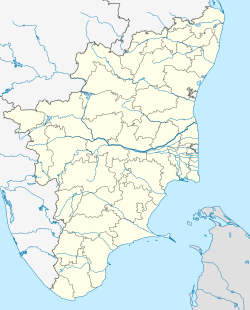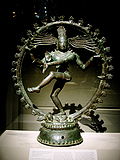Swetharanyeswarar Temple
| Swetharanyeswarar Temple | |
|---|---|
Parvathi) | |
| Festivals | Tamil Masi Month 10 days |
| Location | |
| Location | Thiruvenkadu, Tamil Nadu, India |
| State | Tamil Nadu |
| Country | India |
Location in Tamil Nadu | |
| Geographic coordinates | 11°10′31″N 79°48′34″E / 11.17528°N 79.80944°E |
| Architecture | |
| Type | Dravidian |
| Completed | 1000-2000 years old |
Swetharanyeswarar Temple is a
The temple complex covers around two acres and entered through a seven-tiered gopuram, the main gateway. The temple has a number of shrines, with those of Swetharanyesarar, Aghora and that of Nataraja, being the most prominent. All the shrines and the three temple tanks of the temple are enclosed in large concentric rectangular granite walls.
The temple has six daily rituals at various times from 6:00 a.m. to 8:00 p.m., and four yearly festivals on its calendar. Chitra Pournami and Aani Thirumanjanam during the Tamil month of Aaani (June–July) are the most prominent festivals celebrated in the temple.
The original complex is believed to have been built by
Legend
Swetharanyeswarar is the main God in this temple. It is said that Agora Murthi was one of the furious incarnation of Shiva. There was a demon named Maruthuvasuran in Thiruvengadu. He performed penance to please Brahma for attaining special powers. Pleased by his devotion, Brahma offered him special powers. Maruthuvasuran started misusing his powers to torture the saints and innocent people. All the suffering saints and people requested Shiva to put an end to their hardship. Shiva took an incarnation as Agoramurthi and killed Maruthuvasuran under a tree which is believed to be the place where Thiruvengadu temple is located. The place is called by other names like Swetaranyam, Adi Chidambaram and Nava Ntirya Stala.[1] Indra, Airavata, Budhan, Surya and Chandra are said to have worshipped Swetharanyeswarar here.
As per Hindu legend, Achyutha Kalappalar, a local chieftain was childless. His guru Sivacharya analyzed his horoscope and read out an ancient palm leaf manuscript. It had the verse of Sambandar, one of the major Saivite saints Nayanars. Chieftain was advised to pray at Venkadu to be blessed with a progeny. He prayed at the place along with his wife and was blessed with a boy. The boy, Meykandadevar, later went on to write Sivagnana Bodham.[2]
As per some Hindu legend, Budhan, was the child of
History

From the stone inscriptions found inside this temple, it can be seen that the earlier
Architecture

Swetharanyeswarar temple is located in
A
Festivals

The temple follows Saivite tradition. The temple priests perform the
Vaikasi Visagam celebrated during the Tamil month of Vaikasi (May - June), Aaadi Mulaikattu festival celebrated during the Tamil month of Aadi (August - September), Navaratri during the Tamil month of Purattasi (September - October) and Aipasi Kolattam festival during the Tamil month of Aipasi (October - November)are the most prominent festivals celebrated in the temple. There are other common festivals like Shivaratri, Vinayaga Chaturthi, Vijayadasami and Karthigai Deepam celebrated in the temple.[9] There are many festivals which are being celebrated in this village. It includes the chariot festival which is celebrated every year in the month of February. This Chariot festival is celebrated for 10 days. On 5th day a special occasion is celebrated for Agora Murthi. People from many surrounding villages would come here and pray here for their better life.
Religious importance

The temple is one of the nine Navagraha temples of Tamil Nadu and is a part of the popular Navagraha pilgrimage in the state - it houses the image of Budha (Mercury).[10] The planets are believed to influence the horoscope computed based on time of one's birth and subsequently influence the course of life. Each of the planets are believed to move from a star to another during a predefined period and thus sway over an individual's fortunes. The Navagrahas, as per Hindu customs, are believed to provide both good and bad effects for any individual and the bad effects are mitigated by prayers. As in other Navagraha temples, the common worship practises of the devotees include offering of cloth, grains, flowers and jewels specific to the planet deity. Lighting a set of lamps is also commonly followed in the temple.[2] As per contemporary Saivite belief, the energies distributed cyclically by Navagrahas can be channeled based on remedial measures. As per local legends, Shiva, the overlord of the nine planetary deities, allowed them to freely grant wishes based on devotion of the devotees.[11]
References
- ^ V., Meena (1974). Temples in South India (1st ed.). Kanniyakumari: Harikumar Arts. p. 31.
- ^ ISBN 978-81-88661-42-8.
- ^ "Navagraha temples". Thanjavur District Administration. Archived from the original on 12 November 2013. Retrieved 7 July 2013.
- ISBN 978-81-87952-12-1.
- ^ Thondaman, R. Vijayakumar (5 May 2006). "An exploration on foot". Friday Review. The Hindu. Retrieved 25 November 2018.
- ISBN 9781642497656.
- ^ T.S., Dr. Sridhar, ed. (2011). An exhibition on Chola bronzes - 1000th anniversary of Thanjavur Big temple celebration (PDF) (Report). Chennai: Department of Archaeology & Government Museum. p. 16.
- ISBN 81-206-0151-3.
- ^ a b "Sri Suvedaranyeswarar temple". Dinamalar. 2014. Retrieved 31 May 2014.
- ISBN 9781482847864.
- ISBN 978-1-4438-8381-8.
- ISBN 9781645876250.




